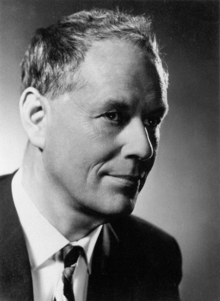Pehr Edman
| Pehr Victor Edman | |
|---|---|

Taken in 1968
|
|
| Born |
April 14, 1916 , Sweden |
| Died | March 19, 1977 (aged 60) Munich, Germany |
| Residence | Sweden, Australia, United States, Germany |
| Nationality |
Swedish (1916-65) Australian (1965-77) |
| Fields | Biochemistry |
| Institutions | Rockefeller Institute of Medical Research, Princeton University, University of Lund, St. Vincent's School of Medical Research, Max-Planck-Institut of Biochemistry |
| Alma mater | Karolinska Institutet |
| Doctoral advisor | Eric Jorpes |
| Known for | Edman degradation, sequenator |
| Notable awards |
Fellow of the Australian Academy of Science (1968) Britannica Australia Prize (Science, 1968) Swedish Society of Physicians and Surgeons (Gold Medal, 1971) Fellow of the Royal Society (1974) |
Pehr Victor Edman (April 14, 1916 — March 19, 1977) was a Swedish biochemist. He developed a method for sequencing proteins, the Edman degradation.
Edman was born in , Sweden. In 1935 he started studying medicine at Karolinska Institutet, where he became interested in basic research and received a bachelor in medicine in 1938. His research was interrupted by the outbreak of World War II, where he was drafted to serve in the Swedish army. He returned to the Karolinska Institutet where he earned his doctoral degree under advice from Professor Erik Jorpes in 1946.
At the time Edman started working on Angiotensin, it was just being recognized that proteins are distinct entities with a defined molecular mass, electric charge and structure. This inspired Edman to develop a method, that could be used to determine the sequence of amino acids in the protein. In 1947 he was awarded a travel stipend to go to Rockefeller Institute of Medical Research. When he returned to Sweden in 1950 to be an Assistant Professor at the University of Lund. In 1950 he published his first paper using the method later known as Edman degradation, to determine the sequence of a protein. To his death he continued to work to improve the method to be able to determine longer stretches with smaller amounts of sample.
In 1957 he moved to Australia to be the director of St. Vincent's School of Medical Research. In 1967 he successfully developed an automated protein sequencer, called the sequenator, with his assistant Geoffrey Begg.
...
Wikipedia
